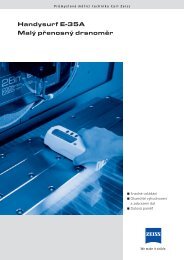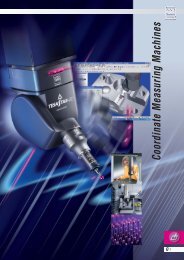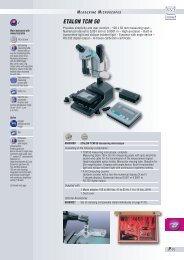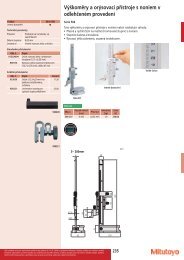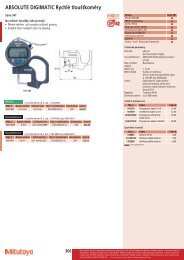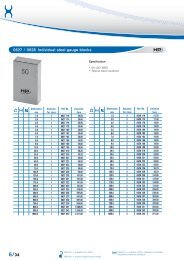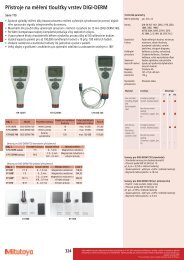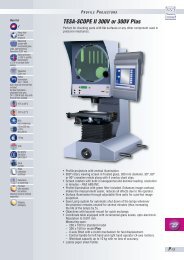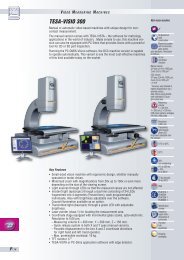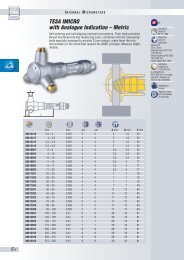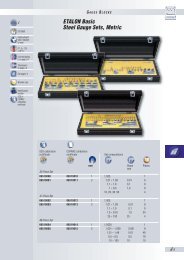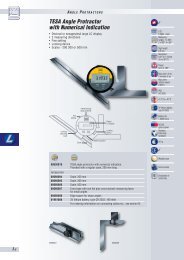TESA Axial Probes - Microtes
TESA Axial Probes - Microtes
TESA Axial Probes - Microtes
Create successful ePaper yourself
Turn your PDF publications into a flip-book with our unique Google optimized e-Paper software.
E LECTRONIC L ENGTH M EASURING E QUIPMENT - ANALOGUE<br />
<strong>TESA</strong> LENGTH MEASURING<br />
EQUIPMENT WITH INDUCTIVE PROBES<br />
<strong>TESA</strong> offers a complete family of value sensors (electronic probes) as well as dedicated<br />
measuring instruments for the most demanding applications. Our standard probes – also<br />
known as half-bridge probes – operate according to the electrical principle. They do not<br />
require any special setting.<br />
Electronic probes that are used in conjunction with measuring instruments from other manufac -<br />
turers work partly on the basis of a differential transformer. These probes are known as LVDT<br />
(Linear Variable Differential Transformer) probes. <strong>TESA</strong> also offer a full range of this kind of<br />
probes which, however, need to be fitted with a convenient socket and further adapted,<br />
accordingly.<br />
For more details about <strong>TESA</strong> half-bridge or LVDT inductive probes, read the information that<br />
follows.<br />
Countless Measuring Capabilities<br />
All <strong>TESA</strong> electronic probes can either be used with hand-held tools, whether internal or external,<br />
or in conjunction with other typical measuring devices and supports.<br />
<strong>TESA</strong> can supply such executions as axial probes with linear displacement of the meas uring bolt,<br />
angled probes with inclinable lever or probes with parallel guiding that are specially designed<br />
for multigauging devices as well as any other equipment for in-process inspection – thus allowing<br />
to spare many assembly components.<br />
With a very few exceptions, these probes perform comparative measurement, essentially. Based<br />
on a master standard, which can either be a gauge block, a setting ring or any other workpiece<br />
accepted as such, a number of sizes are compared on the test piece.<br />
• All measurements are taken with high accuracy. The bias errors usually count for very<br />
little in the uncertainty budget since the comparison is made between two values<br />
nearly equal to the measurand.<br />
• Random errors are also significantly reduced as display setting and all subsequent<br />
measurements are usually made under the same conditions.<br />
• <strong>TESA</strong> provide measuring instruments equipped with an analogue and/or digital display,<br />
depending on their type.<br />
Internal Data Processing<br />
The measurement signals are processed differently according to the measuring application.<br />
Mathematical Data Processing<br />
Signal processing can equally be made with positive or negative polarity signs. The use of one<br />
single probe enables single measurement of internal or external dimensions while the combination<br />
of the signals of two probes produces either a «sum measurement» or a «difference<br />
measurement».<br />
Value Storage<br />
Provides the needed safety for your dynamic measurement cycles. The smallest or highest value<br />
as well as the difference between both values are some of the part features that are questioned<br />
when capturing form and position errors.<br />
Value Classification<br />
Uses limit deviations to classify the measured values while producing additional control signals<br />
usable through a remote unit.<br />
N-2 B-2



